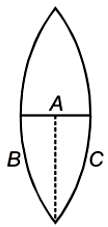A thin rod of length \(\frac{f}{3}\) lies along the axis of a concave mirror of focal length \(f\). One end of its magnified, real image touches an end of the rod. The length of the image is:
1. \(f\)
2. \(\frac{f}{2}\)
3. \(2f\)
4. \(\frac{f}{4}\)
A thin equiconvex lens of power P is cut into three parts A, B, and C as shown in the figure. If P1, P2, and P3 are powers of the three parts respectively, then:

| 1. | \(P_1=P_2=P_3\) | 2. | \(P_1>P_2=P_3\) |
| 3. | \(P_1<P_2=P_3\) | 4. | \(P_2=P_3=2P_1\) |
A medium shows relation between i and r as shown. If the speed of light in the medium is nc then the value of n is:
1. 1.5
2. 2
3. 2–1
4. 3–1/2
A person can see clearly objects only when they lie between 50 cm and 400 cm from his eyes. In order to increase the maximum distance of distinct vision to infinity, the type and power of the correcting lens, the person has to use will be:
| 1. | Convex, +2.25 D |
| 2. | Concave, - 0.25 D |
| 3. | Concave, - 0.2 D |
| 4. | Convex, + 0.15 D |
The speed of light in media and is and respectively. A ray of light enters from medium to at an incidence angle i. If the ray suffers total internal reflection, the value of i is:
| 1. | equal to \(\sin ^{-1}\left(\frac{2}{3}\right)\) |
| 2. | equal to or less than \(\sin ^{-1}\left(\frac{3}{5}\right)\) |
| 3. | equal to or greater than \(\sin ^{-1}\left(\frac{3}{4}\right)\) |
| 4. | less than \(\sin ^{-1}\left(\frac{2}{3}\right)\) |
A boy is trying to start a fire by focusing sunlight on a piece of paper using an equiconvex lens of focal length 10 cm. The diameter of the sun is \(1.39\times 10^9~\text{m}\) and its mean distance from the earth is . What is the diameter of the sun's image on the paper?
1. \(
9.2 \times 10^{-4} \mathrm{~m}
\)
2. \(6.5 \times 10^{-4} \mathrm{~m}
\)
3. \(6.5 \times 10^{-5} \mathrm{~m}
\)
4. \( 12.4 \times 10^{-4} \mathrm{~m}\)
Two convex lenses of focal lengths 10 cm and 30 cm are kept at a separation of 20 cm. Then the correct statement is:
| 1. | The effective focal length is 15 cm. |
| 2. | Chromatic aberration is minimized. |
| 3. | Combination behaves like a convergent lens. |
| 4. | All of these. |
When a ray of light falls on a given plate at an angle of incidence \(60^{\circ}\), the reflected and refracted rays are found to be normal to each other. The refractive index of the material of the plate is:
| 1. | \(\frac{\sqrt{3}}{2} \) | 2. | \(1.5 \) |
| 3. | \(1.732 \) | 4. | \( 2\) |
An object is placed 20 cm in front of a concave mirror of a radius of curvature 10 cm. The position of the image from the pole of the mirror is:
1. 7.67 cm
2. 6.67 cm
3. 8.67 cm
4. 9.67 cm
If \(C_1,~C_2 ~\mathrm{and}~C_3\) are the critical angle of glass-air interface for red, violet and yellow color, then:
| 1. | \(C_3>C_2>C_1\) | 2. | \(C_1>C_2>C_3\) |
| 3. | \(C_1=C_2=C_3\) | 4. | \(C_1>C_3>C_2\) |



